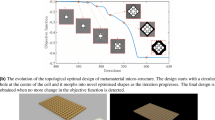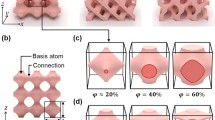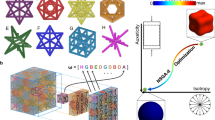Abstract
Developing mechanical metamaterials through topology optimization attracts high attention in both computational design and engineering applications. However, most of the studies in the literature are of quite limited applicability and poor extensibility. Hence, this work originally established an adaptable metamaterial topology optimization framework through integrating a commercial finite element analysis (FEA) platform. Particularly, the sensitivity analysis was derived and simplified to avoid the complex extraction of internal FEA information according to the strain-energy-based homogenization method. A series of two- and three-dimensional metamaterials with different properties, i.e., bulk and shear moduli, negative Poisson’s ratio, were subsequently devised. These optimized metamaterials were fabricated and experimentally tested based on the additive manufacturing, firmly demonstrating the effectiveness of the developed design framework. This well-structured design framework can be conveniently extended to the systematic design of metamaterials with various other exclusive performances, fulfilling the urgent need for metamaterial design methods.



Similar content being viewed by others
Availability of Data and Material
All data generated during this study are included in this published paper and related supporting information.
References
Vangelatos Z, Gu GX, Grigoropoulos CP. Architected metamaterials with tailored 3D buckling mechanisms at the microscale. Extreme Mech Lett. 2019;33:100580.
Ling B, Wei K, Qu Z, Fang D. Design and analysis for large magnitudes of programmable Poisson’s ratio in a series of lightweight cylindrical metastructures. Int J Mech Sci. 2021;2021(195):106220.
Wei K, Peng Y, Wang K, Duan S, Yang X, Wen W. Three dimensional lightweight lattice structures with large positive, zero and negative thermal expansion. Compos Struct. 2018;188:287–96.
Liu P, Yan Y, Zhang X, Luo Y, Kang Z. Topological design of microstructures using periodic material-field series-expansion and gradient-free optimization algorithm. Mater Des. 2021;199:109437.
Zhou S, Cadman J, Chen Y, Li W, Xie YM, Huang X, et al. Design and fabrication of biphasic cellular materials with transport properties—a modified bidirectional evolutionary structural optimization procedure and MATLAB program. Int J Heat Mass Transf. 2012;55:8149–62.
Xia L, Breitkopf P. Design of materials using topology optimization and energy-based homogenization approach in Matlab. Struct Multidiscip Optim. 2015;52:1229–41.
Andreassen E, Clausen A, Schevenels M, Lazarov BS, Sigmund O. Efficient topology optimization in MATLAB using 88 lines of code. Struct Multidiscip Optim. 2011;43:1–16.
Lagaros ND, Vasileiou N, Kazakis G. AC# code for solving 3D topology optimization problems using SAP2000. Optim Eng. 2019;20:1–35.
Zuo ZH, Xie YM. A simple and compact Python code for complex 3D topology optimization. Adv Eng Softw. 2015;85:1–11.
Chen Q, Zhang X, Zhu B. A 213-line topology optimization code for geometrically nonlinear structures. Struct Multidiscip Optim. 2019;59:1863–79.
Sigmund O. A 99 line topology optimization code written in Matlab. Struct Multidiscip Optim. 2001;21:120–7.
Bendsoe MP, Sigmund O. Topology optimization: theory, methods, and applications. Berlin: Springer; 2013. p. 16–8.
Suresh K. A 199-line Matlab code for Pareto-optimal tracing in topology optimization. Struct Multidiscip Optim. 2010;42:665–79.
Schmidt S, Schulz V. A 2589 line topology optimization code written for the graphics card. Comput Vis Sci. 2011;14:249–56.
Talischi C, Paulino GH, Pereira A, Menezes IF. PolyTop: a Matlab implementation of a general topology optimization framework using unstructured polygonal finite element meshes. Struct Multidiscip Optim. 2012;45:329–57.
Liu K, Tovar A. An efficient 3D topology optimization code written in Matlab. Struct Multidiscip Optim. 2014;50:1175–96.
Tavakoli R, Mohseni SM. Alternating active-phase algorithm for multimaterial topology optimization problems: a 115-line MATLAB implementation. Struct Multidiscip Optim. 2014;49:621–42.
Huang X, Xie M. Evolutionary topology optimization of continuum structures: methods and applications. New York: Wiley; 2010. p. 110–2.
Wang S, Wang MY. Radial basis functions and level set method for structural topology optimization. Int J Numer Meth Eng. 2006;65:2060–90.
Challis VJ. A discrete level-set topology optimization code written in Matlab. Struct Multidiscip Optim. 2010;41:453–64.
Otomori M, Yamada T, Izui K, Nishiwaki S. Matlab code for a level set-based topology optimization method using a reaction diffusion equation. Struct Multidiscip Optim. 2015;51:1159–72.
Wei P, Li Z, Li X, Wang MY. An 88-line MATLAB code for the parameterized level set method based topology optimization using radial basis functions. Struct Multidiscip Optim. 2018;58:831–49.
Olesen LH, Okkels F, Bruus H. A high-level programming-language implementation of topology optimization applied to steady-state Navier–Stokes flow. Int J Numer Meth Eng. 2006;65:975–1001.
Zegard T, Paulino GH. GRAND3—ground structure based topology optimization for arbitrary 3D domains using MATLAB. Struct Multidiscip Optim. 2015;52:1161–84.
Sun Z, Li D, Zhang W, Shi S, Guo X. Topological optimization of biomimetic sandwich structures with hybrid core and CFRP face sheets. Compos Sci Technol. 2017;142:79–90.
Zhang W, Yuan J, Zhang J, Guo X. A new topology optimization approach based on Moving Morphable Components (MMC) and the ersatz material model. Struct Multidiscip Optim. 2016;53:1243–60.
Sun Z, Cui R, Cui T, Liu C, Shi S, Guo X. An optimization approach for stiffener layout of composite stiffened panels based on moving morphable components (MMCs). Acta Mech Solida Sin. 2020;33:650–62.
Bendsøe MP, Sigmund O. Material interpolation schemes in topology optimization. Arch Appl Mech. 1999;69:635–54.
Funding
This research was supported by the Science and Technology Innovation Program of Hunan Province under grant #2021RC30306, Natural Science Foundation of Hunan Province under grant #2021JJ30085, the fund of State Key Laboratory of Advanced Design and Manufacturing for Vehicle Body under Grant #52,175,012, and the Open Research Fund of State Key Laboratory of High Performance Complex Manufacturing, Central South University under Grant # Kfkt2021-01.
Author information
Authors and Affiliations
Contributions
Zhengtong Han provided all the data for this paper and was a major contributor in writing this paper; Xiaoyang Liua, Yuhang Longa, Jialong Lia and Xinglin Chen made great contributions to the revision of this paper; Kai Wei conceived the main idea of this paper and also put forward valuable suggestions for the revision of this paper. All authors read and approved the final manuscript.
Corresponding author
Ethics declarations
Conflict of interest
The authors declare that they have no competing interests.
Supplementary Information
Rights and permissions
Springer Nature or its licensor (e.g. a society or other partner) holds exclusive rights to this article under a publishing agreement with the author(s) or other rightsholder(s); author self-archiving of the accepted manuscript version of this article is solely governed by the terms of such publishing agreement and applicable law.
About this article
Cite this article
Han, Z., Wei, K., Liu, X. et al. Developing Mechanical Metamaterials Under an Adaptable Topology Optimization Design Framework. Acta Mech. Solida Sin. 36, 306–316 (2023). https://doi.org/10.1007/s10338-023-00379-y
Received:
Revised:
Accepted:
Published:
Issue Date:
DOI: https://doi.org/10.1007/s10338-023-00379-y




